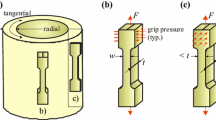Summary
Because of the uncomplicated specimen prepara- tion und test procedure, the uniaxial tensile strength is evaluated indirectly by the tensile splitting test, the so called Brazilian test, and not by the time consuming direct uniaxial tension test. The strength characteristic values generally are not only dependent on the material but also on the specimen size, shape and loading condition. This contribution is part of an extensive examination programme and compares the Brazilian Brazilian test after ISRM with the tensile splitting test according to OENORM B 3124-4. A combination of control modes is presented, which differ from the guideline used by the ISRM and the standard used by the OENORM, however, it immediately detects the tension crack and avoids a wrong tensile strength result. The authors hope for a lively discussion in which suggestions on examinations are particularly desired.
Zusammenfassung
Die einaxiale Zugfestigkeit wird aus Gründen der einfachen Probenvorbereitung und Versuchsdurchführung indirekt mittels Spaltzugversuch, dem sogenannten Brazilian-Test ermittelt. Damit wird der direkte, einaxiale Zugversuch mit seiner aufwendigen Probenvorbereitung umgangen. Der Spaltzugversuch wird jedoch seit seiner Einführung diskutiert, da sein Versuchsergebnis nicht unbedingt der einaxialen Zugfestigkeit entspricht. Die Festigkeitskennwerte sind im Allgemeinen nicht nur vom Material, sondern auch von der Probengröße, Probenform und Lasteintragung abhängig. In diesem Beitrag wird aus einem umfangreich angelegten Untersuchungsprogramm zunächst nur der Brazilian-Test nach ISRM dem Spaltzugversuch nach ÖNORM B 3124 Teil 4 gegenüberund zur Diskussion gestellt. Abweichend von der Empfehlung bzw. Norm wird eine Versuchsregelung vorgestellt, mit der der Zugriss besonders gut detektiert werden kann und die Zugfestigkeit somit nicht mit einer missinterpretierten höheren Kraft ermittelt wird. Die Autoren hoffen auf eine rege Diskussion, wobei Vorschläge für Untersuchungen besonders erwünscht sind.
Similar content being viewed by others
Literaturverzeichnis
Fairbairn, E.M.R., Ulm, F.-J.: A Tribute to Fernando L.L.B. Carneiro (1913–2001) Engineer and Scientist who invented the Brazilian Test: Materials and Structures/Matériaux et Constructions, Vol. 35, April 2002, pp 195–196
Suggested methods for determining tensile strength of rock materials, part 2: Suggested Method for determining direct tensile strength by the Brazil test, in: The complete ISRM suggested methods for rock characterization, testing and monitoring: 1974–2006, R. Ulusay & J.A. Hudson (Hrsg.), ISBN 978-975-93675-4-1, Commission on Testing Methods, International Society of Rock Mechanics, Ankara, 2007
ÖNORM B 3124-4, Prüfung von Naturstein, Mechanische Gesteinseigenschaften, Einaxiale Zugfestigkeit (Spaltzugfestigkeit), Österreichisches Normungsinstitut, 1981
Author information
Authors and Affiliations
Corresponding author
Rights and permissions
About this article
Cite this article
Pittino, G., Gimpel, M. Indirekte Bestimmung der einaxialen Zugfestigkeit – Teil 1 Brazilian-Test nach ISRM versus ÖNORM. Berg Huettenmaenn Monatsh 156, 476–481 (2011). https://doi.org/10.1007/s00501-011-0041-0
Received:
Accepted:
Issue Date:
DOI: https://doi.org/10.1007/s00501-011-0041-0




